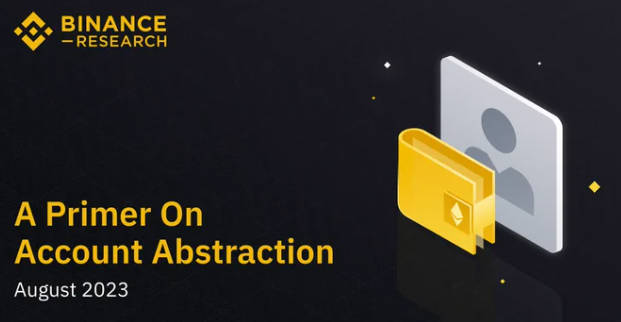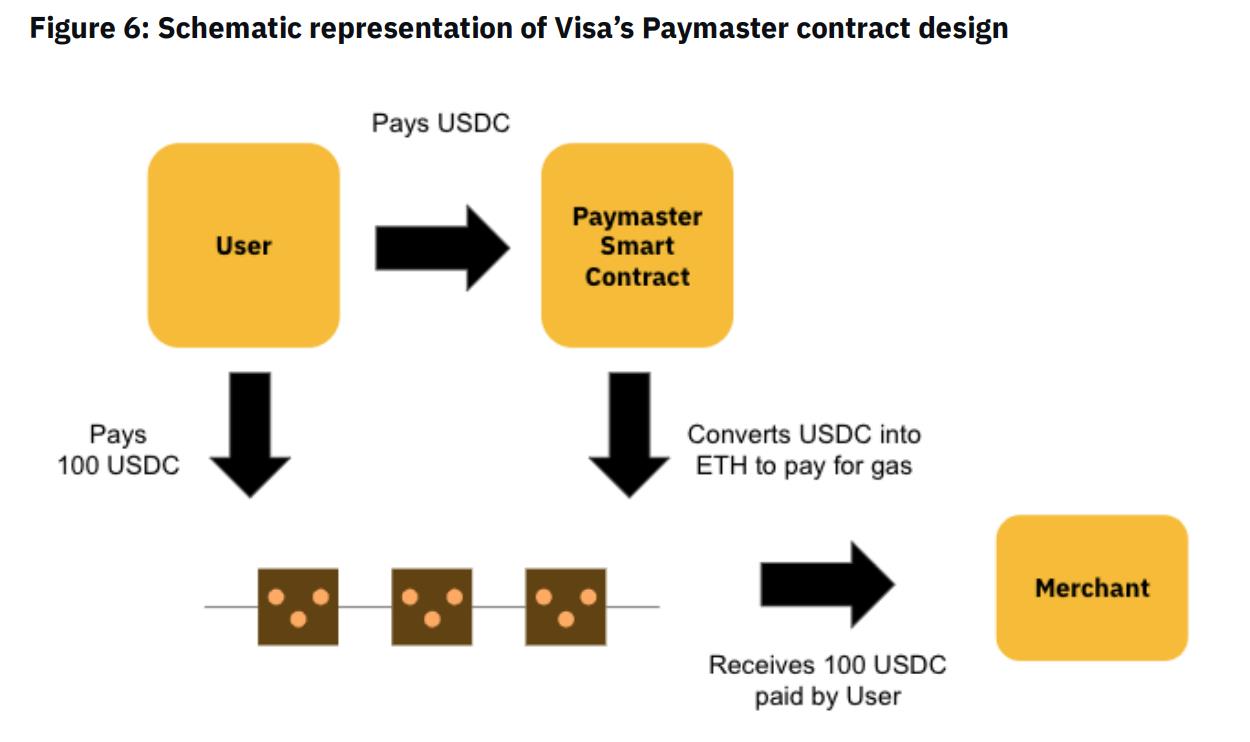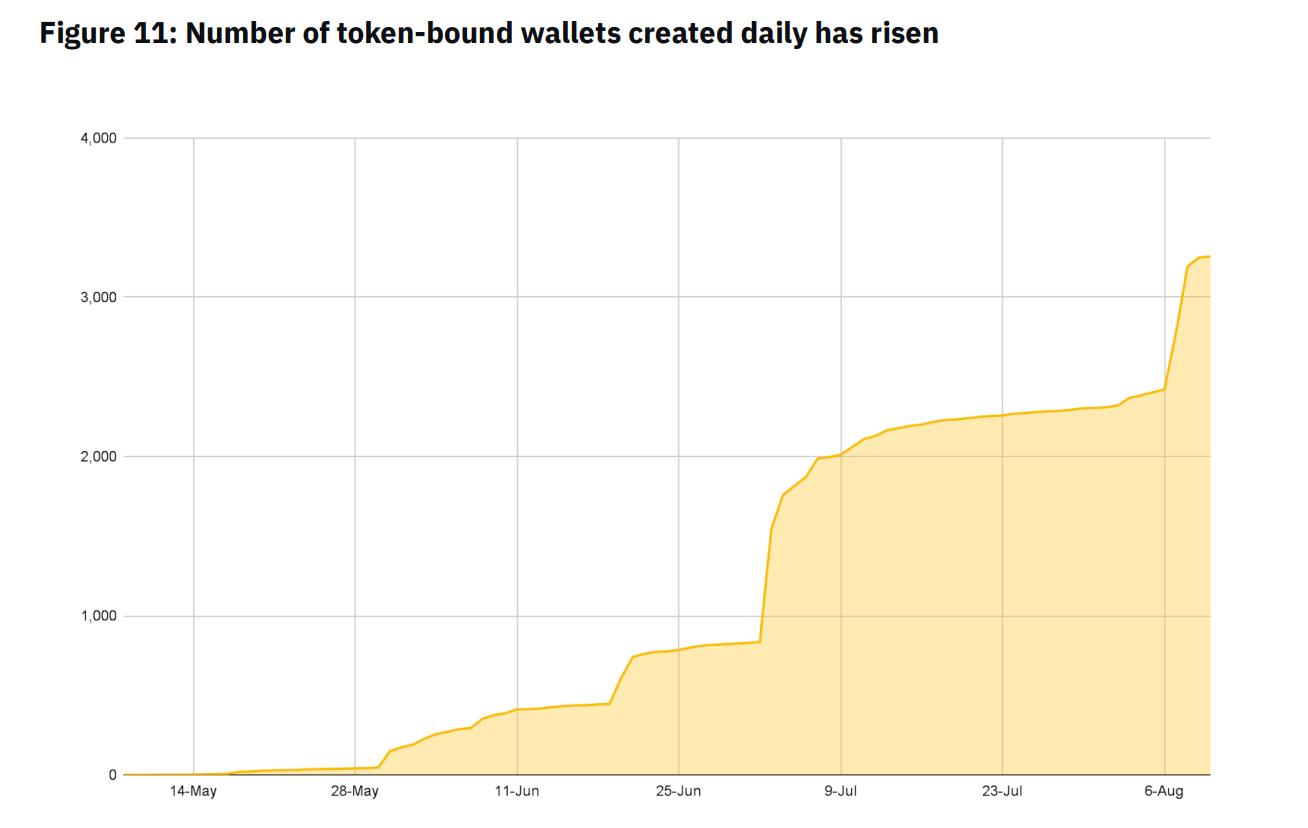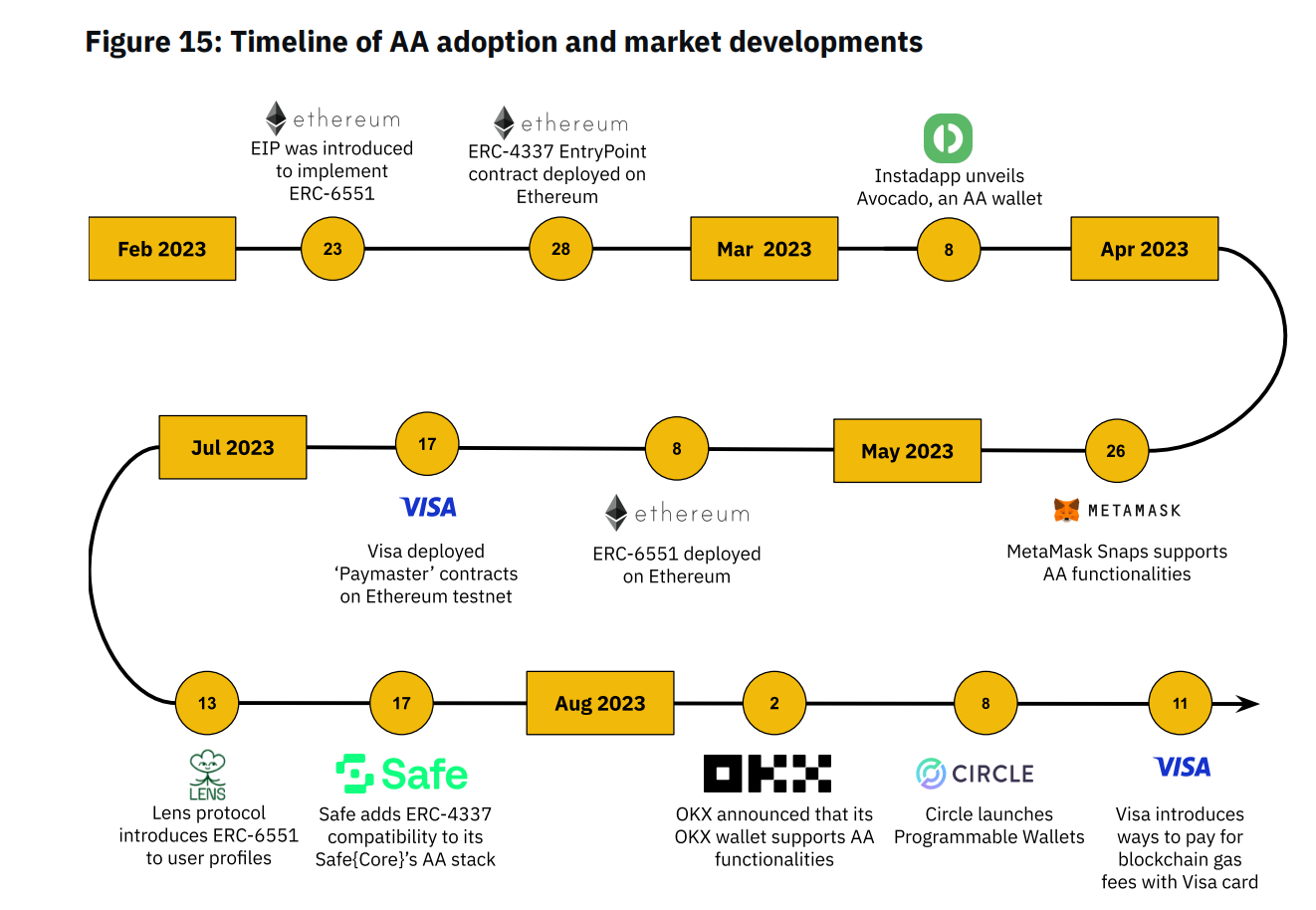币安研究院账户抽象报告解读:发展现状、生态版图、关键用例
原文作者:Colin Chan,Binance Research
原文编译:深潮 TechFlow

账户抽象最近大热。
在过去的 7 月,近 30 万个智能合约账户被创建。同时,市场上的玩家们也跃跃欲试:
OKX 等推出智能合约钱包,StarkNet 和 zkSync 也有原生支持 AA 的方案,Cyber Connect 和 Lens 也在发力...
跳出 AA 是什么的讨论,AA 目前发展的如何,生态版图、可行用例和发展的来龙去脉又是怎样的? 从各类文章和分析中,我们往往只能得到零碎的印象,而无法系统的把握这个赛道和技术的全景。
这两天,币安研究院发布了账户抽象的报告,对上述问题做了系统性的描述和分析。由于报告较长,深潮对该报告进行了解读和提炼,以帮助大家更好的了解核心观点和结论。
关键要点
随着 ERC-4337 的引入,账户抽象(下称 AA)已可在以太坊主网上支持,而无需对核心共识层面进行更改。
StarkNet 和 zkSync 已经推出了原生账户抽象解决方案,Argent 和 Bravoos 等钱包提供商也寻求提供这些方案。
使用案例如传统机构 Visa 也在这个领域开拓,Lens Protocol 和 CyberConnect 也采用了账户抽象,这些都被证明展示了实现的和潜在的好处,以鼓励用户加入Web3环境。
AA 技术实现
关于以太坊账户的分类,如 EOA 和 AA 的区别,在此不赘述,有需要可查看报告原文。
AA 一般的技术实现:可通过下图的关键组件来理解,它们相互作用,允许开发人员构建与链上 dApps 兼容的智能合约钱包。
总结后的流程如下:
用户在前端与抽象层交互,该抽象层将用户操作转换为基础交易。
EntryPoint 智能合约负责验证用户签名,处理由抽象层发起的交易。
Paymaster 合约负责为用户操作支付交易费用。
链上应用程序与用户操作交互,就像与普通外部所有账户一样。
AA 生态版图
AA 生态系统在过去一年中继续扩大,因为开发人员认识到需要更清晰的用户体验和用户与钱包、应用程序及最终用户之间更友好的交互。
通过实施 AA,这有助于增强现有基础设施并扩展用户参与链上活动的可能性的方式。该领域的进步可以广泛分类为“基础设施”和“Social”两部分,具体玩家见图。

基础设施领域的参与角色:
区块链:支持 AA 的 EVM 兼容的区块链和 zk-rollup 扩展解决方案。
钱包提供商:利用 AA 为用户提供特定功能的钱包。
支付:通过 Paymaster 合约提供费用抽象能力,用户无需拥有该区块链的原生代币即可执行数字交易。
社会领域的参与角色:
游戏/NFTs:采用 AA 与代币标准如 ERC-4337 和 ERC-6551 ,以改进链上游戏体验,扩展 NFT 的效用。
社交媒体:结合诸如签名抽象等 AA 形式,允许用户持续使用Web3钱包与社交网络互动。
AA 的市场接受度
关键:ERC-4337 EntryPoint 合约于今年 3 月 1 日正式部署。此后,交易活动和 ERC-4337 智能账户的总数激增,尤其是在 7 月。
智能账户数量稳步增加, 7 月近 30 万个账户被创建,而与之对应的用户操作活动急剧增加。
大多数 AA 活动是由 Polygon 驱动的。这是由于社交网络 CyberConnect 的推出,该网络中的所有账户都是 ERC-4337 钱包。
AA 用例一览
为了理解 AA 的使用案例,报告重点介绍了使用 ERC-4337 和 ERC-6551 等代币标准实现新功能的关键基础设施项目。这些项目以改善最终用户的 UX 为基本目标,旨在推动区块链技术的实际采用。
基于 Paymaster 的支付用例
Paymaster 是 ERC-4337 中的一个组成部分,通俗理解成一个中介,可以接收用户使用的代币,并将其兑换成区块链原生代币来支付手续费。
相关案例如下:
VISA:Visa 展示了使用 Paymaster 合约的解决方案,以抽象出基本的区块链交互并通过自托管的智能合约钱包改善链上用户支付体验。 目前,该案例尚在概念验证阶段,但目的上旨在减少用户通过其钱包进行交易的摩擦,用户可以以任意 token 做 gas 费,并且由 Paymaster 覆盖 gas 成本,探索数字交易对消费者的“未开发的潜力”。

另外,VISA 也有其他举措,旨在让用户使用 visa 卡就能支付 gas 费。
Paymaster 合约的其他使用情况:
总体稳步增长,Optimism 领头。这与 7 月底在 OP 上推出的 Beam 钱包有关,使得用户可以用转账中使用的币来支付手续费,而不用区块链的原生代币。
下图中,Paymaster 合约的 gas 总量大幅增加,表明对这些中介服务的需求正在增长,以简化用户体验。
钱包管理的用例
通过将 AA 整合到现有的钱包解决方案中,这些账户被增强成为具有可编程逻辑的智能合约钱包,提供新的功能,如批量交易和社交恢复。
支持 AA 的钱包管理方案如下:
Safe:
推出多签方案,需要多个授权实体对同一个账户进行签名,而不是单独的私钥。
最近通过可插拔接口集成了 ERC-4337 标准,为开发人员提供了构建和创建钱包的模块。
引入了签名抽象,允许用户根据自己的偏好定制授权钱包发起交易的规则。例如,为了防范可疑活动,用户可以指定支出限额来拒绝某个规模的交易。
Argent:
引入了“社交恢复”的概念,允许用户恢复丢失或遗忘的私钥。
用户可以提名“守护人”,也就是他们信任的其他钱包或账户,作为恢复自己钱包的后援。
或者,用户也可以使用电子邮件地址和手机号码进行链下恢复,引入了熟悉的双因素认证机制。
Braavos:
在 Starknet 上推出的智能钱包,采用了签名抽象的形式。
用户可以使用手机的生物识别特征(如面部或指纹识别)来访问钱包。
委托交易的用例
“可委托账户”利用 AA 使用户可以将签名权限委托给一个经批准的外部合约。该账户包含用户根据自己偏好定制的相关规则,然后与规则中提到的应用程序进行交互,而无需手动批准每笔交易。
VISA 的自动支付方案:
在完全控制钱包的同时,用户可以批准公用事业和订阅账单的自动化支付。
这种委托有效地抽象了签名验证,并改变了应用内的用户交互,以获得更友好的体验。
Lens 的社交用例:
允许用户将签名权限委托给 dispatcher 钱包来执行发帖,评论和更改个人资料;
用户可以不断地与 dApp 交互,而无需每次都进行批准;
dispatcher 还会支付这些交易的燃料费,无需用户持有用于应用内交互的原生代币
此举导致其使用度有一阵子的提高
代币绑定账户用例
ERC-6551 引入了代币绑定账户(TBA)的以太坊标准,赋予 NFT 能力,使其作为“智能合约账户”发挥作用,并通过无许可注册成为自己的钱包。这实现了一个集成机制,允许所有者在 TBA 中托管 NFT。
最近 1 个月,TBA 账户激增:

通过抽象,极大的赋能现有 NFT 以实现以下能力:
实现资产的多层所有权
使 NFT 在生态系统间互操作
降低燃料费,使交易更经济实惠
NFT 获得自己的数字身份
用例:Sapienz 街头文化
Sapienz 项目为数字街头文化带来 ERC-6551 标准。
用户收到一个可自定义的字符,该字符的解锁基于他们所拥有的 NFT。
“字符”是用户获得的可自定义化身。这个化身是一个代表用户的虚拟形象,用户可以根据自己拥有的 NFT 来解锁这个化身的不同外观。他们可以用不同的装饰品配备字符,并根据自己的偏好进行个性化定制。
AA 值得注意的关键发展点
智能合约钱包,目前靠由中介运营的“relayers”来将用户签名的消息转换为典型的以太坊交易
因此,新的L2链为开发人员实验 AA 的可行替代方案,例如:
zkSync 是第一个在协议级实现本地 AA 的 EVM 兼容链。
类似地,zk-rollup 解决方案 StarkNet 也实现了 AA。
Optimistic rollups 如 Optimism 和 Coinbase 的 Base 也实现了 AA 形式。
与 AA 相关的提案和协议:
AA 从提出到目前采纳,半年时间中,关键事件一览:




